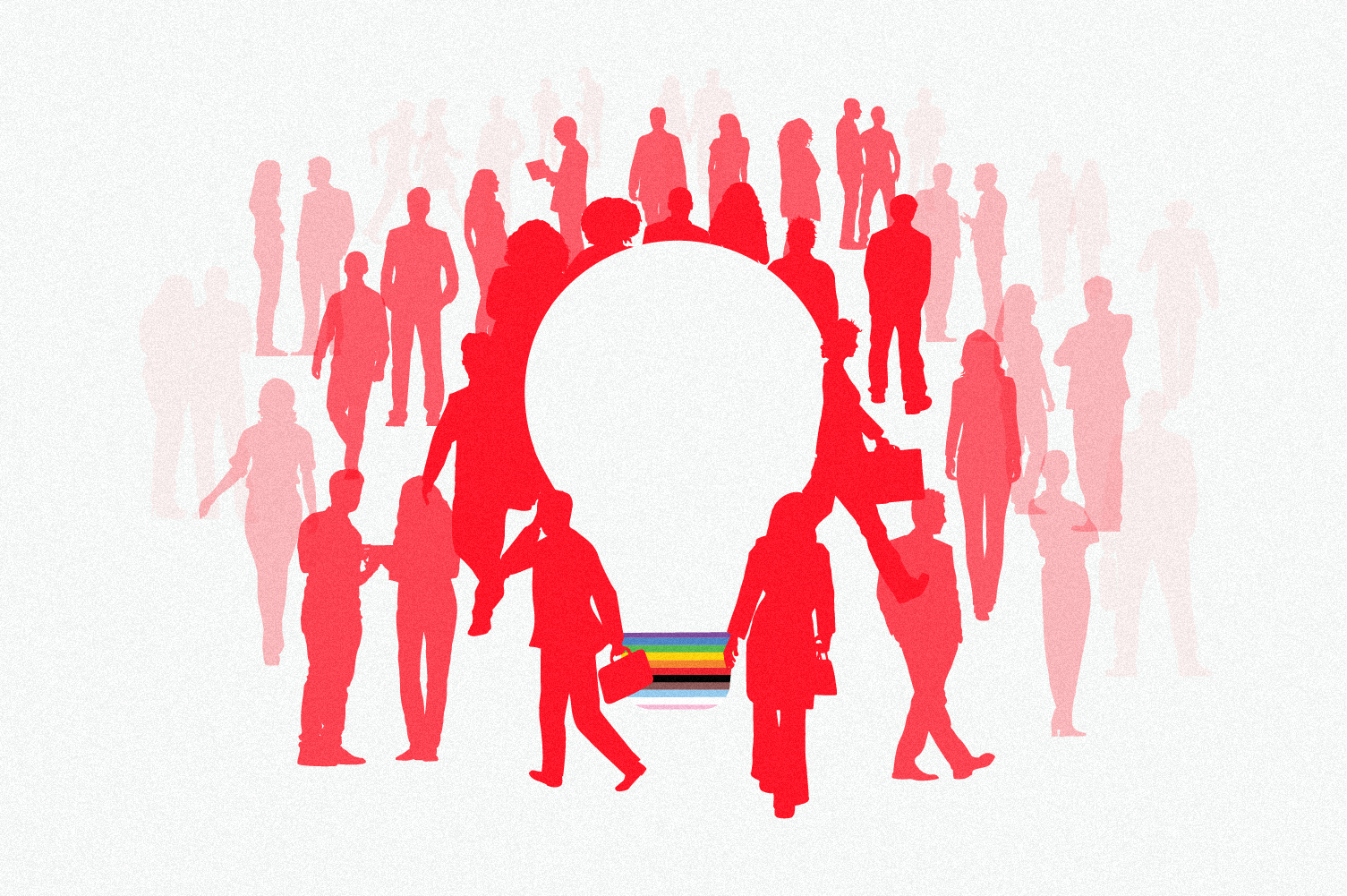Diversity & Inclusion, Leadership & Management
Microaggressions in the workplace don't need to happen. Good allies make sure to avoid their flight-or-fight response when conversations become uncomfortable.
Even when you mean well, it’s easy to get it wrong when talking about identity and diversity.
For people in a more advantaged group, there are simple cognitive and behavioral biases that make it challenging to not say the wrong thing.
How can well-meaning people overcome their bias to create healthier workplaces, instead of causing microaggressions in the workplace to take place?
Professors David Glasgow and Kenji Yoshino, founders of the Meltzer Center for Diversity, Inclusion, and Belonging at NYU School of Law, wanted to help allies overcome their fear with their new book “Say The Right Thing.”
“We felt that one of the things that was missing from the literature was practical, shame-free guidance for people on how to navigate conversations in this area,” says Glasgow.
The book offers a set of tools and principles to help people in a more advantaged group who want to be better allies have the right conversations — and avoid the mistakes that often thwart progress.
Four traps allies must beware
There are four common ways that conversations about identity can go off the rails, according to Glasgow and Yoshino:
- Avoid: when you go quiet, or decline to say what you really think
- Deflect: when you try to change the subject, or redirect the conversation
- Deny: when you reflexively dismiss what the other person says
- Attack: when you make it personal, and go after the other person with sarcasm, insults, etc.
“In all of those four behaviors, the end result is that you are shutting down real engagement in the conversation,” says Glasgow.
These reactions are not always intentional, but are rather a kind of flight-or-fight response to feeling uncomfortable.
“One of the biggest barriers to effective allyship is that people become so emotionally uncomfortable in these conversations that they shut down and they disengage,” Glasgow says.
Allies must instead hone their emotional resilience and fight through their fear, guilt, or whatever other emotion is making them withdraw. By adopting a growth mindset — that is, understanding you will grow over time and do not have a fixed or innate skillset — allies can push through fear to find new knowledge.
Confronting microaggressions in the workplace
Microaggressions in the workplace are the common ways people from more advantaged groups can diminish their marginalized colleagues.
These interactions, often perpetrated by people whose intent is benign, can have severe consequences on workplace culture. Diversity and belonging suffer, leading to a poor employee experience and higher turnover.
But confronting microaggressions in the workplace requires care. Rather than getting on the moral high horse, allies should use tactics that are effective in changing behavior.
Glasgow recommends two strategies:
1. Separate the behavior from the person.
When someone feels their character is under attack, they won’t be open to exploring how they might change their behavior. “Focus on the impact of the behavior, rather than focusing on making accusations of ill intent,” Glasgow says.
He gives the example: “You may have intended that as a joke, but I felt uncomfortable about it because…”
2. Show your learning.
“When you are confronting someone else, oftentimes the other person can feel threatened by that because they think that you're approaching them as a moral superior,” Glasgow says.
Instead, you can position yourself as a learner, and also share about your own journey in trying to be more inclusive. Glasgow offers the example:
"I didn't like that comment, but I've made very similar comments in the past. Here's how I recovered from that. I'm coming to you as a colleague because I know that you're an inclusive person and I would want you to do the same for me. And when I mess up next week, I hope you'll come to me and talk to me about it as well."
Leaders set the tone
Improving your one-on-one interactions is great, but how can you build a more inclusive culture across an organization? It starts with leaders — who set the tone — leading by example.
“If you're a leader, you are the one who's really setting the culture for the team and setting the example for other people and modeling that behavior,” says Glasgow. Important behaviors include showing curiosity and care for others, being respectful when you disagree, and apologizing authentically when you make a mistake.
Glasgow also believes leaders should be willing to challenge microaggressions in the workplace when they appear.
“If you leave them unchallenged and you let non-inclusive behavior run rampant within your team or within your organization, you can hardly expect that people with less power in the organization are going to stand up,” he says. “It’s your responsibility.”
Another recommendation for diversity, equity, inclusion and belonging (DEIB) progress is to use positive, affirmative language when rolling out new initiatives.
When you focus on negatives — “you need to do this or else you will be trouble” — DEIB interventions become less effective, Glasgow says. “A compliance, or legal lens can often generate backlash and doesn't really lead to long-term behavior change.”
Instead, he recommends framing actions to be more inclusive with positive language: “We all have an opportunity here as allies to contribute to an inclusive culture together. It's going to make for a better workplace, it's going to make sure that we get the best out of each other, out of our teams.”
Build curiosity
When people aren’t curious about their colleagues, it’s hard to create a more inclusive workplace. That’s because people in a more advantaged group are inherently less aware of the issues that matter to marginalized groups.
“Often in these conversations, there's a lot of things that you don't know about,” says Glasgow.
He gives the example of someone without a disability engaging with someone who is a wheelchair user. That person without the disability probably hasn’t had to learn about disability issues, so they are likely unaware of a whole host of issues, from ramps and restrooms to unfair stereotypes that are often applied to wheelchair users.
To combat this knowledge gap, Glasgow and his co-author recommend a simple task: Try to increase your knowledge about unfamiliar subjects. The tools are readily available: books, podcasts, websites, and more.
However, the one of the highest barriers to clear is that you don’t know what you don’t know.
Transgender issues offer a clear example of this challenge.
“People sometimes think that they understand what it means to be transgender, but they don't realize that you can be trans even if you have not undergone gender confirmation surgery, or you're not on hormones,” Glasgow says.
In these cases, a simple web search might not be enough to help you understand the limits of your knowledge. This is when Glasgow and Yoshino recommend an approach borrowed from philosopher Kristie Dotson — imagine yourself entering a nuclear physics seminar.
“If you are a non-nuclear physicist and you go to a nuclear physics seminar, even if you do all the assigned readings beforehand, you are going to still enter with a posture of radical humility,” Glasgow explains. “You're going to go into the class aware that you're ignorant of this subject, you're going to listen really intently to what the other person is saying, you are going to wonder if you are really getting it.”
In practice, this requires surrendering your sense of surety and inviting in the perspective of the other person.
“Really listen generously in case there's something that you're missing that you might be getting wrong — and then when you're sharing your own perspective, do it tentatively,” Glasgow says.
Case in point, rather than saying “don’t make this about gender” or “this isn’t about race,” there’s another way to express your perspective that leaves room for someone else’s view.
“A way of doing it that displays curiosity would be to flip that and say something like, ‘I don't really see the gender dimensions of this issue, but I may be missing something. Can you tell me more? What do you see here?’" Glasgow says.
Subscribe
Learn how to create an award-winning company culture. Subscribe to the Great Place To Work® company culture newsletter and join 100,000+ other leaders learning how to create a great workplace.











